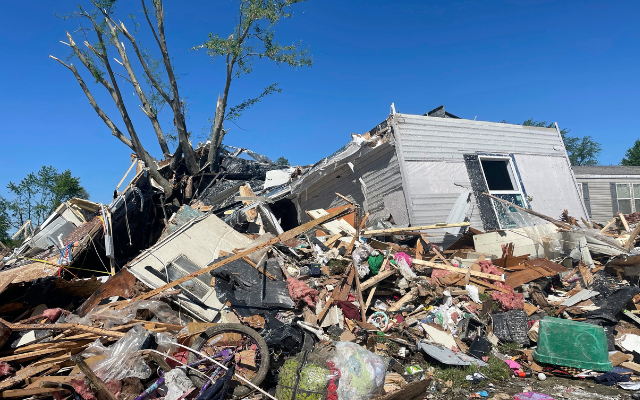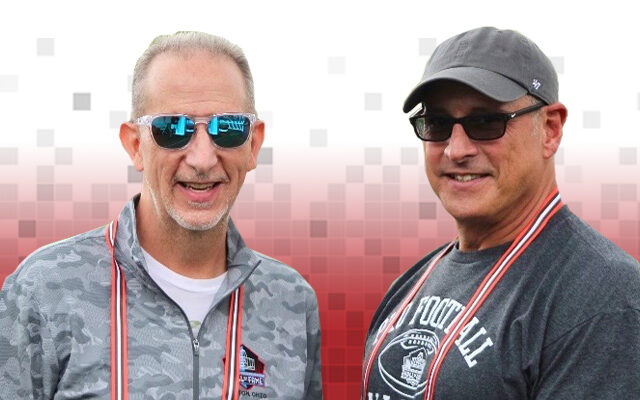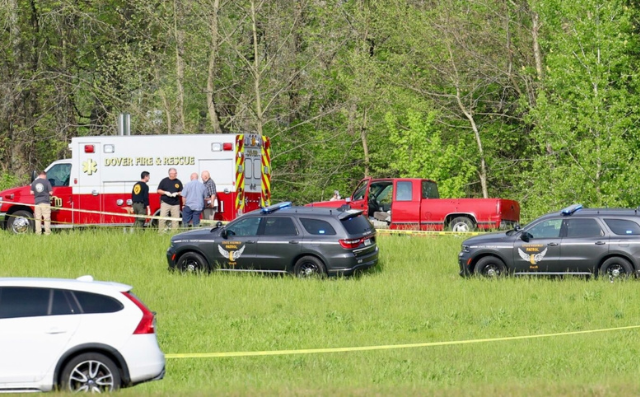Wednesday Recap: More Steps Taken to Protect First Responders, 105 Inmates to Be Released

COLUMBUS (News Talk 1480 WHBC) – Once again, Governor Mike DeWine along with other state leaders and health officials spoke in Columbus, providing updates on COVID-19 in Ohio. Here is a recap on everything that was discussed.
Update on Cases
The Ohio Department of Health’s latest report shows that there are now 7,791 total cases of COVID-19 in the Buckeye State. 37 more Ohioans died from the Coronavirus, increasing the state’s death total to 361.
2,237 people have been hospitalized in Ohio from COVID-19; 677 have been admitted into the intensive care unit. Over 71,000 COVID-19 tests have been given throughout the state. Ohio has a positive test rate of around 10.8%.
.@DrAmyActon: Today’s #COVID19 data dashboard for #Ohio. These numbers are still the tip of the iceberg. pic.twitter.com/REDzas3f8s
— Governor Mike DeWine (@GovMikeDeWine) April 15, 2020
Stark County Update
Stark County is now up to 176 cases of COVID-19. 48 people have been hospitalized in the county due to the virus. Stark’s death total remains at 17.
Ohio Extends Partnership with Battelle
As the state continues to work toward providing health care professionals with the required amount of personal protective equipment to fight against the virus, Governor DeWine announced this afternoon that Ohio will now begin to do the same for first responders.
Ohio will be expanding its partnership with Battelle to extend their sanitation services to law enforcement agencies and EMS providers in the state.
The Ohio Department of Public Safety and Battelle have now partnered to sanitize N-95 masks for all of Ohio’s first responders. Battelle is providing this service for free.
Governor DeWine says the Ohio State Highway Patrol has developed a statewide collection and distribution system to make this process as simple as possible for local first responders.
Beginning this Friday, local law enforcement agencies and EMS agencies can bring their packaged N-95 masks to any Ohio State Highway Patrol post in the entire state.
The patrol will then bring those masks to Battelle, in Columbus, where they will be sanitized. Once they are cleaned, the state patrol will bring the masks back to each post, and agencies can then come back and pick them up.
“This will contribute greatly to our efforts to protect Ohio’s protectors,” DeWine said. “The patrol will be sending out guidelines to local law enforcement and EMS agencies soon on how the masks must be packaged.”
DeWine added that this process was developed by Ohio’s Public Safety Strike Forc. He says it is a good example of our first responder members identifying a problem and working with their state partners on a solution.
More Testing Coming Soon
Health systems worldwide have struggled because of the critical shortage of test kit components, including the swabs used to collect samples and the sterile solution needed to transport the swabs.
Recognizing the shortage, a rapidly assembled team of Ohio State researchers worked overnight and, within 24 hours, created an in-house “recipe” to make the crucial liquid transport medium.
Additionally, the Wexner Medical Center and Ohio State’s colleges of Medicine, Engineering, and Dentistry, along with the Center for Design and Manufacturing Excellence, Infectious Diseases Institute, and Institute for Materials Research, collaborated with a national consortium that rapidly deployed a design and testing program for 3D printed testing swabs.
Ohio State is part of the academic-industry-government consortium led by Harvard, the U.S. Army, and the University of South Florida that designed the swabs.
Ohio State teams are working with 3D Manufacturing companies, including Form Labs, Inc. in Toledo, and academic institutes across the State of Ohio to manufacture these swabs and swab kits in significant amounts for the citizens of Ohio.
The first order of 15,000 3D printed swabs for COVID-19 test kits will be delivered to Ohio State, with a target of 200,000 swabs and swab kits to be shared in partnership with the Ohio Department of Health and hospital systems in Ohio, allowing more people to be tested by the end of April.
Update on the Prison Issue
Governor DeWine reported this afternoon that Ohio now has two more probable inmate deaths at the Pickaway Correctional facility.
“We are waiting on confirmation test results to know for certain if these inmates had the coronavirus,” said DeWine. “My team has been working on different strategies to create more room for social distancing within our state prisons.”
Last week, under an overcrowding statute in Ohio law, DeWine alerted the Correctional Institution Inspection Committee to overcrowding in Ohio prisons and advised them of the state’s intent to release certain inmates who were already set for release in the next 90 days.
“We set forth strict criteria for those who we’d consider for early release,” said DeWine. “We eliminated anyone convicted of ex offenses; homicide-related offenses; kidnapping; abduction; ethnic intimidation; making terroristic threats; and domestic violence.”
The state also screened out those who:
- Have been denied judicial release in the past
- Have prior incarcerations in Ohio
- Are inter-state offenders; have warrants or detainers
- Those who have serious prison rule violations in the last 5 years
Yesterday, the Correctional Institution Inspection Committee agreed with the state’s limited overcrowding determination and recommended the early release of inmates who fit our specific criteria.
Earlier today, Governor DeWine approved the early release of 105 inmates in Ohio. Each inmate will be tested to determine if they have COVID-19 before release.
Furthermore, DeWine has authorized the Ohio Department of Rehabilitation and Correction to continue to use this criteria every day as more people qualify for release within 90 days to identify other inmates who may qualify for release under the limited overcrowding statute.
DeWine also mentioned that Ohio dropped its overall prison population by 311 inmates last week because of the efforts of the local courts to reduce their jail populations and to hold only critical hearings.
“This has resulted in a drastic reduction in the number of inmates being sent to our state prisons and has allowed for more room for social and physical distancing,” said DeWine. “We expect this trend to continue throughout this crisis.”
Unemployment Update
Lt. Governor Jon Husted spoke about the state’s on-going efforts to improve Ohio’s unemployment system. He says progress has made but he and other state leaders are still nowhere near satisfied.
“I’ve felt we need to do a better job of getting more answers out there about the unemployment process,” said Husted. “I want to share with you what I’ve learned.”
Husted said that he believes everyone working at Ohio JFS understands that improvements must be made. However, he also stressed that it is simply not a issue that can be fixed overnight.
“For perspective, the system was built in 2004. It is very outdated in terms of technology,” said Husted. “A cloud-based system doesn’t exist right now. The system worked fine pre-pandemic.”
There were 42 people in the call center prior to COVID-19. Now there are 1,194 people in there taking calls, which Husted says is still is not enough. More claims were filed in the last month than in the last two years.
Update Just for Kids
Dr. Amy Acton says the state is currently working on doing a “just for kids” update in the near future. She mentioned that in the mean time, Ohio has information for parents that will help explain what is happening to their children.
“We have a lot of information there on how parents can talk with their kids about COVID-19,” said Acton.
You can access those resources right here.
We Won the Battle, but Not the War
Governor DeWine continued to deliver high praise toward Ohioans social distancing efforts. However, as he has said before, he once again mentioned that the fight against COVID-19 will still continue for quite some time.
“I’ve felt all along that, as Governor, we have to tell people what we know, when we know it,” said DeWine. “We will continue to do that. The sad truth is that we’ve won the battle, it appears we’ve flattened the curve, but the monster is still out there.”
The Governor added that Ohio has to figure out how it can emerge from this in the safest way possible for businesses, schools, and all of its citizens.



